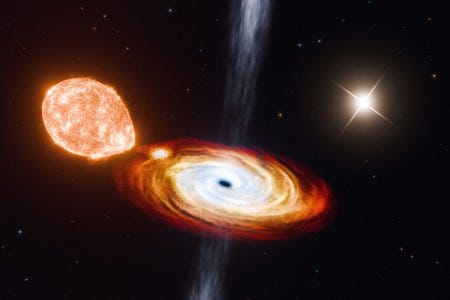First Evidence of a “Black Hole Triple”: A Milestone Discovery
This triple black hole system not only calls into question long-held assumptions about black hole formation but also opens up new avenues of research in astrophysics.

A Milestone Discovery
In a landmark discovery, MIT and Caltech physicists have uncovered the first known example of a "black hole triple," a unique system comprising a black hole and two stars orbiting within an immense distance from each other. Observed around 8,000 light-years away, this configuration sheds new light on black hole formation and challenges the longstanding view that black holes typically arise from violent supernovae.
Traditional Black Hole Pairs: A Known Model
Most previously identified black holes exist in binary pairs, involving a black hole and another tightly orbiting body, like a star or neutron star. These binaries emerge from the gravitational attraction between the black hole and its companion, forming a high-energy system where the black hole may consume matter from the partner star, releasing radiation detectable from Earth.
The Discovery: Introducing a Triple System
The newly discovered system, V404 Cygni, is the first observed instance of a “black hole triple,” where a black hole captures and holds two separate stars in orbit. One star spirals closely to the black hole every 6.5 days, providing light as it loses matter to the black hole. The second, however, is remarkably distant, orbiting the black hole approximately every 70,000 years. This gravitational interaction raises questions about how such a loosely bound system could form and remain intact, as the energy from a traditional supernova would have expelled the outer star.
A Gentle Collapse? Evidence of Non-Supernova Black Hole Formation
The discovery raises the possibility that this black hole may have formed through “direct collapse,” a gentler process where a star collapses inward without an explosive supernova. In such a scenario, minimal energy would be released, allowing the loosely bound distant star to remain gravitationally connected. This hypothesis challenges the conventional view that black holes form predominantly through energetic stellar explosions.
Serendipitous Observations: Aladin Lite and Gaia Reveal Hidden Details
Kevin Burdge and his team identified the triple system using Aladin Lite, a digital repository of astronomical data. Reviewing images of V404 Cygni, Burdge noticed two light sources close together, representing the black hole's inner and outer stars. Later analysis through the Gaia satellite, which tracks star movements across the galaxy, revealed that these stars were indeed moving together—a clear sign of their gravitational link.
Testing the Theory: Simulations Support Direct Collapse
To validate the system’s formation theory, Burdge ran tens of thousands of simulations to model different scenarios. He found that direct collapse scenarios, where a star quietly contracts into a black hole, were the most compatible with the observed structure. In contrast, simulations of explosive supernova events repeatedly showed the outer star being ejected, highlighting direct collapse as the most plausible explanation.
A Window into the Black Hole’s Age and Evolution
The age of the outer star, now entering the red giant phase, offers additional insights. Estimated to be about 4 billion years old, the outer star likely formed at the same time as the black hole, suggesting that V404 Cygni’s black hole has also existed for 4 billion years. This rare observation gives astrophysicists a unique look at the life cycle of black holes, especially those formed through less violent processes.
Implications and Future Prospects
This triple black hole system not only calls into question long-held assumptions about black hole formation but also opens up new avenues of research in astrophysics. As Burdge and his colleagues suggest, there may be more such triple systems waiting to be discovered, each offering further insight into the diverse ways in which black holes can emerge and evolve in our galaxy.



